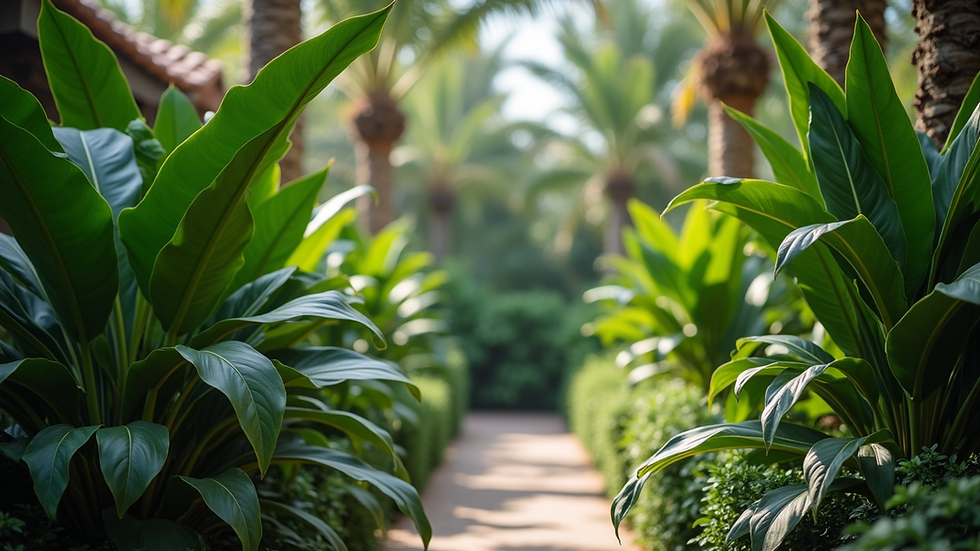Tips for Growing and Caring for Palm Trees
- Brandon Hall

- May 5
- 3 min read
Palm trees are a beautiful addition to any landscape. Their tall, slender trunks and lush green fronds evoke a sense of tropical paradise, making them popular in gardens and backyards. Whether you live in a warm climate or simply want to bring a touch of the tropics to your home, knowing how to grow and care for palm trees can ensure they thrive. Here, we provide essential tips for maintaining healthy and vibrant palm trees.
Understanding Palm Trees
Palm trees belong to the family Arecaceae, which includes over 2,500 species. They are known for their distinctive appearance, typically featuring a tall trunk and a crown of leaves at the top. These trees are versatile and can be found in a variety of environments, from beaches to deserts.
When growing palm trees, understanding their specific needs is crucial. Some palm tree species prefer full sun, while others thrive in partial shade. The important thing is to choose a variety that suits your local climate and soil conditions.

Tips for Growing Palm Trees
Choose the Right Location: Palm trees generally require plenty of sunlight. Look for a spot in your yard that receives minimum 6 hours of direct sunlight daily. If you live in a cooler region, ensure the area is sheltered from strong winds that can damage the leaves.
Soil Type: Well-draining soil is essential for palm trees. You can improve soil drainage by mixing in sand or perlite. Avoid heavy clay soils, as they retain too much water and can cause root rot.
Watering Needs: Palm trees need a moderate amount of water. Water them thoroughly when the top inch of the soil feels dry. Depending on the climate, this may mean watering every week or every few days. During colder months, reduce the frequency of watering.
Fertilization: Use a slow-release, balanced fertilizer designed for palm trees during the growing season, usually in spring and summer. Fertilizers should contain essential nutrients like potassium, magnesium, and iron to promote healthy growth.
Pruning: Regular pruning helps maintain a palm tree's health and appearance. Remove dead or yellowing fronds to prevent pests and diseases. Make sure to cut at the base of the frond, ensuring a clean cut.

Are There Any Palm Trees That Can Survive Winter?
Yes, certain types of palm trees can survive winter, especially in areas that experience mild winters. For instance, the Windmill Palm (Trachycarpus fortunei) is known for its cold hardiness and can withstand temperatures as low as 5°F (-15°C).
Another option is the Needle Palm (Rhapidophyllum hystrix), which is popular in the southeastern United States for its resilience. If you live in an area prone to frost, consider planting these hardier varieties or safeguarding your palms with frost blankets during severe weather.
It's important to check your local climate and select palm tree species that suit your hardiness zone. This can ensure your palm trees thrive through varying seasonal conditions.
Common Pests and Diseases
Like any plant, palm trees can face challenges from pests and diseases. Early detection is crucial for effective management. Some common issues include:
Aphids: These small insects feed on palm sap and can lead to yellowing leaves. Regularly inspect your palms and treat infestations with insecticidal soap.
Scale Insects: Scale insects appear as small bumps on the fronds and can weaken the tree. Treat them with horticultural oil.
Fungal Diseases: Overwatering can lead to fungal infections such as leaf spot. Ensure good drainage and allow the soil to dry between watering.
If you see any unusual signs on your palm trees, take immediate action to prevent spreading and further damage.
Creating Ideal Conditions
To give your palm trees the best chance of thriving, it's essential to create ideal conditions:
Mulching: Apply a layer of mulch around the base of the palm tree. This helps retain moisture, suppress weeds, and regulate soil temperature. A 2-3 inch layer of organic mulch works well.
Spacing: When planting multiple palm trees, ensure that there is adequate spacing between them. This encourages good air circulation and reduces competition for resources.
Companion Plants: Consider planting companion plants that thrive in similar conditions. They can enhance the aesthetic appeal and provide mutual benefits, such as shade or wind protection.

Final Thoughts on Palm Tree Care
Caring for palm trees can be a rewarding endeavor. By selecting the right variety and following proper cultivation methods, you can enjoy the beauty of palm trees in your landscape. Consider reaching out to local experts or resources, such as ct palm trees, for tailored advice for your area. With the right care, your palm trees can thrive and become the crowning glory of your garden.
Remember, patience is key. Whether you’re nurturing young saplings or caring for established palms, consistent care will go a long way in helping them flourish. Happy gardening!









Comments